The following distribution and phytogeographic information concerning Acacia is provided here:
- Worldwide distribution of Acacia
- Distribution of Australian species of Acacia
- Geographic patterns of species-richness of Australian Acacias
The current classification views Acacia comprising five major groups, each of which is likely to be given separate generic status at some future date (see Maslin et al. 2003 for summary [760 Kb PDF]). The names of these groups are Acacia subgenus Acacia, Acacia subgenus Aculeiferum, Acacia subgenus Phyllodineae, Acacia section Filicinae and an undescribed group called ‘Genus x’. These groups are discussed individually below; the name Acacia sens. lat. is used here when referring to these groups collectively.
Note: The information below was assembled in 2004. Since then there has been some (relatively minor) changes to the the species numbers that are cited. Elsewhere WorldWideWattle now provides access to more current species numbers and lists for (and infrageneric placement of species) for acacias found throughout the world.
Worldwide distribution of Acacia
Acacia sens. lat. is a large, cosmopolitan genus containing in excess of 1350 described species. These species grow in tropical, subtropical and warm temperate parts of the world where they occur in African (144 species), Asia (89 species), the Americas (about 185 species) and the Australia – Pacific region (993 species).
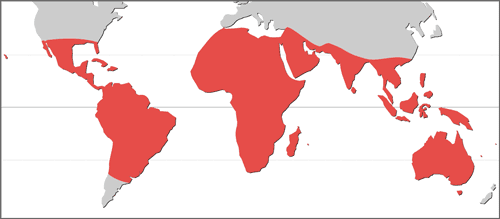
Indicative distribution of Acacia.
Details of the distributions of the individual groups of Acacia are as follows (based on information presented in Maslin et al. 2003).
Subgenus Acacia
A cosmopolitan group containing about 161 species that are distributed thus:
- Americas - about 60 species.
- Africa (including Madagascar) - 73 species.
- Asia (including about 15 species that occur also in Africa) - 36 species.
- Australia - 9 species.
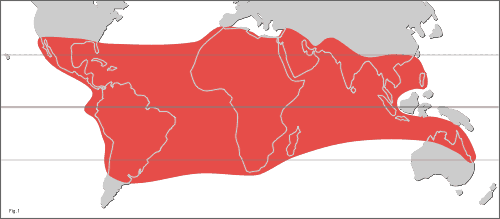
Indicative distribution of Acacia subg. Acacia
Subgenus Aculeiferum sens. str.
A cosmopolitan group containing about 203 species that are distributed thus:
- Americas - 97 species (plus about another 20 as yet undescribed).
- Africa (including Madagascar) - 69 species.
- Asia (including about 7 species that occur also in Africa) - 43 species.
- Australia (including A. pennata subsp. kerrii, which extends to Asia) - 2 species.
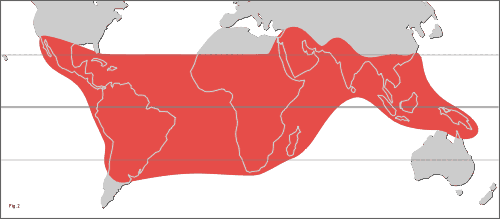
Indicative distribution of Acacia subg. Aculeiferum sens.
str.
Subgenus Phyllodineae
This enormous group of 987 described, accepted species is largely confined to Australia. The 19 species of subg. Phyllodineae which occur outside Australia are found in the Pacific region east to Hawaii (7 species), Asia north to the Taiwan (3 species) plus Madagascar and the Mascarene Is. in the Indian Ocean off the east coast of Africa (2 species). Seven of these species also occur in Australia. The extra-Australian species, except A. pubirhachis (which occurs in Papua-New Guinea), are detailed in Pedley (1975).
Further information on the distribution of the Australian acacias is given below.
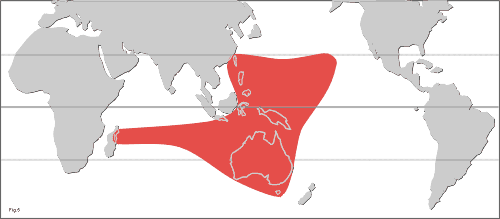
Indicative distribution of Acacia subg. Phyllodineae
Section Filicinae
This New World group of 15 species extends from the south-central U.S.A. south to Argentina; the highest concentration of species occurs in Mexico.
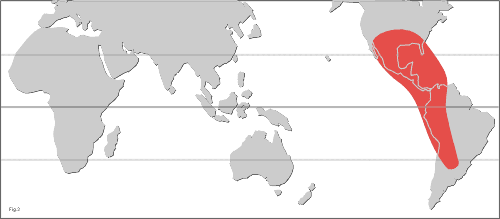
Indicative distribution of Acacia subg. Aculeiferum sect.
Filicinae
Genus x (A. coulteri group)
This New World group of 13 species represents a distinct, but presently undescribed, genus (Jawad et al. 2000). It extends from Arizona south through Mexico to Costa Rica.
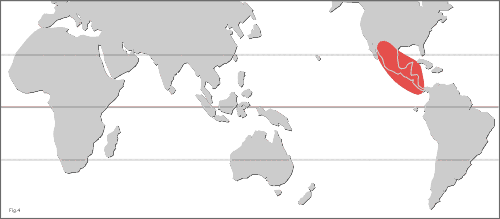
Indicative distribution of the genus x (Acacia coulteri group)
Distribution of Australian species of Acacia
Individual species distribution maps (small scale dot maps) for Australian Acacias are provided on the WATTLE CD (Maslin 2001) and in the Flora of Australia (Orchard & Wilson 2001 and 2001a). These maps may be accessed via the WorldWideWattle Species Gallery.
Species distribution maps, generated in real-time and based on specimen point-source data held by major Australian herbaria, are also available through Australia’s Virtual Herbarium. These map can be requested by accessing an AVH node via the Council of Heads of Australian Herbaria website.
Distribution maps based on species occurrences in 1 x 1.5 degree grids are provided for many Australian Acacias in Maslin & Pedley (1982). However, not all species currently recognized for Australia are covered by these maps, furthermore, the maps are now a little out of date.
Maps of South Australian species are given in Whibley & Symon (1992) and of the Victorian species in Entwistle et al. (1996). For Western Australian species visit the FloraBase website.
Geographic patterns of species-richness of Australian Acacias
Within Australia Acacia species are represented in most ecosystems where they occupy a wide range of soil types within many climatic regimes.
The patterns of species richness of Acacia within Australia, based on individual species distributions, are discussed by Hnatiuk & Maslin (1988) and Maslin & Pedley (1988) and are shown below in a series of isoflor maps (i.e. species-richness maps). The Hnatiuk & Maslin study showed that precipitation was more important than temperature in governing Acacia distribution patterns on a national scale (NB. edaphic and geological variables were not included in the study).
Regional phytogeographic studies of the Australian Acacia flora include the following:
- Western Australia: Hopper & Maslin (1978), Maslin (1982 – Pilbara region), Maslin (1982a – Wongan Hills), Hnatiuk et al. (1983)
- Queensland: Pedley (1978)
- Central Australia: Maslin & Hopper (1982)
- Northern Australia: Hnatiuk & Pedley (1985)
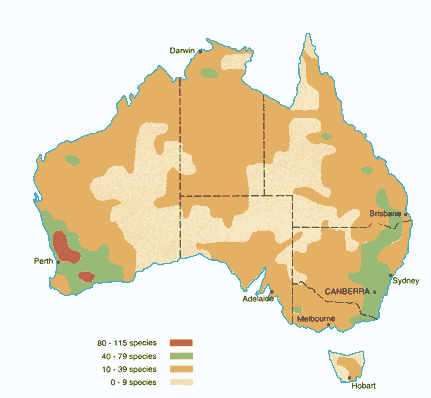
Areas of species-richness of Acacia within Australia. This map
was originally published in Maslin (1997) - see also a larger
version.
Major centres of species richness
The two major areas of species richness for Acacia in Australia are:
- The semi arid inland region of southwest Western Australia along the boundary separating the Arid Zone from the more humid South West Botanical Province.
- Along the tablelands associated with the Great Dividing Range south of the Tropic of Capricorn in eastern Australia.
These areas of richness are dominated by species of section Phyllodineae.
Secondary centres of species richness
Important secondary centres of richness occur in northern and north eastern Australia, a number of the rocky tablelands of the Arid Zone and in western Victoria. It is species of section Juliflorae that are primarily responsible for these secondary centres of richness.
Species poor areas
The sandy deserts and riverine areas separating the centres of richness are species poor even though, in the deserts at least, Acacia is a common element of the landscape.
Species-richness maps of the Australian Acacia flora
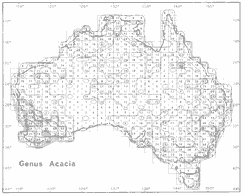
Isoflor map of the genus Acacia in Australia showing patterns
of species richness (view
a larger version). Numbers indicate species recorded in each 1 x
1.5 degree grid cell; isoflor interval is 10. Although the total
number of described, accepted species recorded for Australia is
now about 975 the basic geographic patterns depicted by this map (which
was based on 840 species) remain essentially unaltered. The map was
originally published by Maslin & Hnatiuk (1987) and reproduced in
Hnatiuk & Maslin (1988).
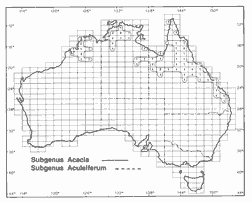
Isoflor map of Acacia subgenus Acacia and Acacia
subgenus Aculeiferum in Australia (view
a larger version). Numbers indicate species recorded in each grid;
isoflor interval is 10. Although subgenus Acacia now contains
about 9 species and subgenus Aculeiferum 2 species the basic
geographic patterns depicted by this map (which was based on 6 and 1
species respectively) remain essentially unaltered. The map was originally
published by Maslin & Hnatiuk (1987) and reproduced in Hnatiuk &
Maslin (1988).
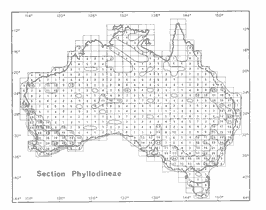
Isoflor map of Acacia section Phyllodineae in Australia
(view
a larger version). Numbers indicate species recorded in each grid;
isoflor interval is 10. Although section Phyllodineae now contains
about 397 described, accepted species the basic geographic patterns
depicted by this map (which was based on 352 species) remain essentially
unaltered. The map was originally published by Maslin & Hnatiuk
(1987) and reproduced in Hnatiuk & Maslin (1988).
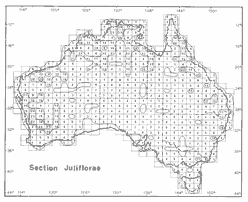
Isoflor map of Acacia section Juliflorae in Australia
(view
a larger version). Numbers indicate species recorded in each grid;
isoflor interval is 10. Although section Juliflorae now contains
about 255 described, accepted species the basic geographic patterns
depicted by this map (which was based on 219 species) remain essentially
unaltered. The map was originally published by Maslin & Hnatiuk
(1987) and reproduced in Hnatiuk & Maslin (1988).
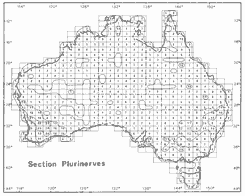
Isoflor map of Acacia section Plurinerves in Australia
(view
a larger version). Numbers indicate species recorded in each grid;
isoflor interval is 10. Although section Plurinerves now contains
about 216 described, accepted species the basic geographic patterns
depicted by this map (which was based on 178 species) remain essentially
unaltered. The map was originally published by Maslin & Hnatiuk
(1987) and reproduced in Hnatiuk & Maslin (1988).
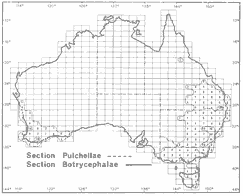
Isoflor maps of section Pulchellae and section Botrycephalae
in Australia (view
a larger version). Numbers indicate species recorded in each grid;
isoflor interval is 10. Although section Botrycephalae now contains
about 40 described, accepted species the basic geographic patterns depicted
by this map (which was based on 36 species) remain essentially unaltered;
section Pulchellae currently contains 26 species, the same number
as when this map was constructed. The map was originally published by
Maslin & Hnatiuk (1987) and reproduced in Hnatiuk & Maslin (1988).
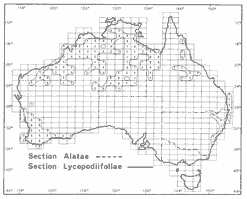
Isoflor maps of Acacia section Alatae and section Lycopodiifoliae
in Australia (view
a larger version). Numbers indicate species recorded in each grid;
isoflor interval is 10. Although section Lycopodiifoliae now
contains about 18 described, accepted species the basic geographic patterns
depicted by this map (which was based on 11 species) remain essentially
unaltered; section Alatae (an artificial group) currently contains
23 described, accepted species, the same number as when this map was
constructed. The map was originally published by Maslin & Hnatiuk
(1987) and reproduced in Hnatiuk & Maslin (1988).
References
Entwistle, T.J., Maslin, B.R., Cowan, R.S. and Court, A.B. (1996). Mimosaceae. In: N.G. Walsh and T.J. Entwistle (eds) Flora of Victoria. Volume 3. (Inkata Press: Melbourne.)
Hnatiuk, R.J. and Maslin, B.R. (1988). Phytogeography of Acacia in Australia in relation to climate and species-richness. Australian Journal of Botany 36: 361-383.
Hnatiuk, R.J., Maslin, B.R. and D'Antuono. (1983). The distribution of Acacia (Mimosoideae) in Western Australia. Part 3. Numerical analysis of pattern and ecological correlations. Western Australian Herbarium Research Notes 8: 1-21.
Hnatiuk, R.J. & Pedley, L. (1985). Biogeography of Acacia in northern Australia. Proceedings of the Ecological Society of Australia 13: 33-42.
Hopper, S.D. and Maslin, B.R. (1978). Phytogeography of Acacia in Western Australia. Australian Journal of Botany 26: 63-78.
Jawad, J.T., Seigler, D.S. and Ebinger, J.E. (2000). A systematic treatment of Acacia coulteri (Fabaceae, Mimosoideae) and similar species in the New World. Annals of the Missouri Botanical Garden 87: 528-548.
Maslin, B.R. (1997). Australia’s golden future. Landscope 12(3): 16-22.
Maslin, B.R. (1982). Studies in the genus Acacia (Leguminosae: Mimosoideae) - 11. Acacia species of the Hamersley Range area, Western Australia. Nuytsia 4(1): 61-103.
Maslin, B.R. (1982a). Studies in the genus Acacia (Leguminosae: Mimosoideae) - 10. Acacia species of the Wongan Hills, Western Australia. Nuytsia 4(1): 29-46.
Maslin, B.R. (coordinator) (2001). WATTLE Acacias of Australia. CD ROM Publication. (Published by Australian Biological Resources Study, Canberra and Department of Conservation and Land Management, Perth).
Maslin, B.R. and Hnatiuk, R.J. (1987). Aspects of the phytogeography of Acacia in Australia. pp. 443-457. In: Stirton, C.H. (ed.) 'Advances in Legume Systematics' Part 3. (Royal Botanic Gardens, Kew: England.)
Maslin, B.R. and Hopper, S.D. (1982). Phytogeography of Acacia (Leguminosae: Mimosoideae) in Central Australia. pp. 301-316. In: Barker, W.R. and Greenslade, P.J.M. (eds.) 'Evolution of the Flora and Fauna of Arid Australia.' (Peacock Publications: Adelaide.)
Maslin, B.R., Miller, J.T. and Seigler, D.S. (2003). Overview of the generic status of Acacia (Leguminosae: Mimosoideae). Australian Systematic Botany 16: 1-18.
Maslin, B.R. and Pedley, L. (1982). The distribution of Acacia (Leguminosae: Mimosoideae) in Australia. Part 1. Species distribution maps. Western Australian Herbarium Research Notes 6: 1-128.
Maslin, B.R. and Pedley, L. (1988). Patterns of distribution of Acacia in Australia. Australian Journal of Botany 36: 385-393.
Orchard, A.E. and Wilson, A.J.G. (2001) (eds). Flora of Australia Volume 11A, Mimosaceae, Acacia part 1. (ABRS/CSIRO Publishing: Melbourne.)
Orchard, A.E. and Wilson, A.J.G. (2001a) (eds). Flora of Australia Volume 11B, Mimosaceae, Acacia part 2. (ABRS/CSIRO Publishing: Melbourne.)
Pedley, L. (1975). Revision of the extra-Australian species of Acacia subg. Heterophyllum. Contributions from the Queensland Herbarium 18: 1-24.
Pedley, L. (1978). A revision of Acacia Mill. in Queensland. Austrobaileya 1: 75-234.
Whibley, D.J.E. and D.E. Symon (1992). Acacias of South Australia. (South Australian Government Printer: Adelaide.)